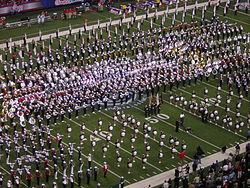
Halftime show
Performance given between halves of a sporting event / From Wikipedia, the free encyclopedia
Dear Wikiwand AI, let's keep it short by simply answering these key questions:
Can you list the top facts and stats about Halftime show?
Summarize this article for a 10 years old
A halftime show is a performance given during the brief period between the first and second halves, or the second and third quarters, of a sporting event. Halftime shows are not given for sports with an irregular or indeterminate number of divisions (such as baseball or boxing), or for sports that do not have an extended period of stoppage in play. Ice hockey games consist of three periods, so there are in effect two halftimes at a hockey game: the first intermission is between the first and second periods, and the second intermission comes between the second and third periods. The intermissions are usually given over to contests involving randomly selected audience members, although for major games, like the Winter Classic, the Stanley Cup Finals, the NHL All-Star Game and the Frozen Four, the intermission between the 2nd and 3rd period often features entertainment typically found during halftime shows.[1]


The invention of the halftime show is generally credited to Walter Lingo. Lingo was the owner of a dog kennel and sponsored an all-Native American football team, the Oorang Indians, to tour the country and promote the kennel. In addition to playing football, the Indians would provide various forms of entertainment, including exhibiting the dogs, players demonstrating their prowess (Nick Lassa once wrestled a bear while Jim Thorpe would kick long-distance field goals), dancing, and demonstrations of native culture. Although the halftime show was in part designed to bring an additional draw to mask the fact that the Indians did not put much effort into the actual game, his halftime show was mostly the same from game to game, and the novelty wore off after two years.[2][3]
A modern halftime show can consist of cheerleading performances, majorette routines, marching bands playing music, or other spectacular performances. Halftime shows are particularly well known among historically black colleges and universities, which have elaborate "battles of the bands" between the opposing schools' marching bands during halftimes of the most prominent games (see, for instance, the Bayou Classic). More common in modern times, especially in major games, is to reserve the entire halftime period for a short concert by a major recording artist.[citation needed]
The halftime show also often describes television studio shows during the intermission which review scores and stories from across the league's schedule during that break between action.